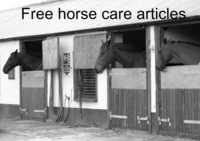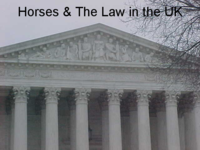On 3 September 2012 the Welshpool Magistrates’ Court found Mr Thomas Bowyer of 6 the Courtyard, Lower Trewylan, Llansantffraid, Powys, SY22 6TJ, guilty of having carried out unlawful farriery.
Under the Farriers (Registration) Act 1975 it is a criminal offence for anyone other than a Registered Farrier, approved farriery apprentice or veterinary surgeon to shoe a horse, or otherwise carry out farriery. The Register of Farriers is administered by the Farriers Registration Council and it is Council policy to pursue a private prosecution when sufficient evidence is available.
To qualify for registration as a farrier, which is a highly skilled profession, persons must, amongst other things complete a four year and two month apprenticeship with an Approved Training Farrier and pass the Diploma of the Worshipful Company of Farriers Examination. Mr T Bowyer is neither a Registered Farrier, an Approved Farriery Apprentice nor a Registered Veterinary Surgeon. The Farriers Registration Act therefore prohibits him from undertaking farriery.
The allegations against Mr Bowyer were that on 1 November 2011 and on 8 December 2011 he undertook farriery on a Welsh Cob Cross Irish horse (“Ronnie”) belonging to Mrs Susan Stafford-Tolley of Brecon, Powys. On both occasions he applied “hoof wraps” to Ronnie’s front hooves. Ronnie had been having some problems, and Mr Bowyer an “equine podiatrist” had advised the owner that the wraps would protect Ronnie’s hooves.
“Hoof wraps” consist of a length of bandage like material which is impregnated with a synthetic, fibreglass-like resin substance which is soft when applied. They are soaked in water before application and within hours, dry, forming a rigid, solid structure around the hoof. In this case they were wrapped around and partially underneath Ronnie’s hooves. The Defendant also screwed the wraps into the horse’s hooves with two screws per hoof.
The Council’s case was that by 13 November 2011 Ronnie had become severely lame on his left fore; and that a veterinary surgeon had confirmed this. The Council’s case was that the veterinary surgeon had removed the wrap using hoof nippers and noted bruising and an impending abscess caused by a loose screw between the sole and the wrap.
On 8 December Mr Bowyer returned to remove the remaining wrap and convinced the owner’s husband that it would be in the horse’s best interests to re-apply the wraps. It was the Council’s case that on 17 December Ronnie was lame again and a veterinary surgeon had attended who removed one wrap with the use of hoof nippers, to find his foot to be very tender which she attributed to pressure from the encircling wrap. On 18 December a Registered Farrier attended to remove the remaining wrap and fit a pair of deep-seated heart-bar shoes.
The Council’s case was that these wraps amounted to “shoes” because they were clearly intended to give protection to the hooves by providing a solid structure between the hoof and the ground, they were left in a place for a number of weeks and were firmly affixed. Once dried out they became solid and immoveable and needed tools to remove them.
Mr Bowyer pleaded guilty to both charges against him and the Magistrates Court imposed a £450 fine per offence, a victim surcharge of £15 and ordered Mr Bowyer to make a contribution towards prosecution costs of £1,000.
It was also the Council’s case that Mr Bowyer’s actions had caused harm to Ronnie. Mr Bowyer denied that they had done so. The Court decided not to hear oral evidence or make findings on the issue of whether harm had been caused to Ronnie as a result of the unlawful farriery to which Mr Bowyer had pleaded guilty.
The Council takes out prosecutions against persons who undertake farriery illegally when the evidence is sufficient to do so and considers the application of “hoof wraps”, as described above, amounts to farriery, or shoeing, for the purposes of the Farriers Registration Act; such products should only be applied by Registered Farriers or Veterinary Surgeons.
Notes:
If any further information is required in relation on this matter any enquiry can be made to the Solicitors to the Council, Ms N Curtis (Partner (Barrister)), Penningtons solicitors, of Abacus House, 33 Gutter Lane, London, EC2V 8AR, telephone: 0207 457 3000.
“Farriery” is defined in section 18 of the Act as “any work in connection with the preparation or treatment of the foot of a horse for the immediate reception of a shoe thereon, the fitting by nailing or otherwise of a shoe to the foot or the finishing off of such work to the foot. ”Shoeing” has the same meaning as farriery.
The product used should not be confused with a simple equine bandage or wrap used to protect a horse’s leg or keep a poultice in place. “Hoof wraps” are impregnated with a resin type substance which sets hard, like a caste, following the application of water.
Unregistered persons engaging in farriery are breaking the law. Any horse owner choosing to use an unregistered person may compromise the welfare of their horse, could incur additional shoeing bills to correct the effects of poor workmanship and may invalidate their insurance if their horse is lamed or injured.
The FRC maintains the Register of Farriers and all Registered Farriers are issued with their own annual Registration Card and Car Window Sticker. If an owner wishes to check the credentials of their farrier he/she can ask to see the card, check the Council’s website (www.farrier-reg.gov.uk) or telephone the office on 01733 319911.






Comments